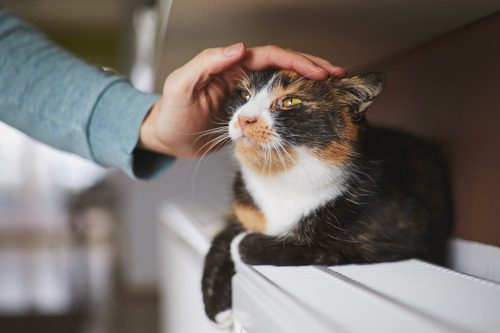Heatstroke in Cats: Signs and Tips for Prevention
Cats are known for their resilience, but they are not immune to the dangers of extreme heat. In Florida’s hot and humid climate, heatstroke in cats is a real risk that pet owners should take seriously. Unlike dogs, cats are more subtle about showing distress, making it crucial for owners to recognize the early signs of overheating before it escalates into a medical emergency. Below, we’ll discuss how heatstroke in cats occurs, its symptoms, and ways to prevent it can help protect your feline friend from this potentially life-threatening condition.

What Causes Heatstroke in Cats?
Heatstroke in cats happens when their body temperature rises to dangerous levels and they are unable to cool down effectively. Unlike humans who sweat to regulate temperature, cats primarily rely on grooming and limited sweat glands on their paw pads to dissipate heat. However, in extreme temperatures, this is not always enough. Some common causes of heatstroke in cats include:
- Being Trapped in Hot Environments: Leaving a cat in a parked car, a poorly ventilated room, or a space without access to shade and water can lead to overheating.
- High Humidity Levels: Florida’s humidity can make it difficult for cats to cool down, even when they seek shade.
- Excessive Physical Activity: Cats that play or exert themselves too much during hot weather are at higher risk.
- Underlying Health Conditions: Overweight cats, senior cats, and those with respiratory conditions are more vulnerable to heatstroke.
- Brachycephalic Breeds: Flat-faced breeds like Persians and Himalayans have a harder time regulating their body temperature, making them more susceptible.
Signs of Heatstroke in Cats
Heatstroke in cats can develop quickly, so it’s important to recognize the symptoms early. If you notice any of the following signs, your cat may be overheating:
- Excessive panting
- Salivating more than usual
- Lethargy or weakness
- Bright red or pale gums
- Rapid heartbeat
- Vomiting or diarrhea
- Trouble walking
- Collapse or seizures
If your cat displays any of these signs, seek immediate veterinary care. Call Keystone Animal Hospital at (941) 741-8445 for professional assistance.
How to Prevent Heatstroke in Cats
Heatstroke in cats is largely preventable with proactive care. By making a few simple changes to your cat’s environment and daily routine, you can reduce the risk of overheating.
Provide a Cool and Shaded Environment
Cats should always have access to shaded areas, especially during peak heat hours. If your cat enjoys spending time outdoors, ensure there are cool, shaded spots available or consider limiting outdoor time to the cooler parts of the day.
Keep Fresh Water Available
Hydration plays a key role in temperature regulation. Ensure your cat always has access to fresh, cool water. Some cats prefer running water, so a pet water fountain can encourage them to drink more frequently.
Limit Physical Activity in Hot Weather
Encourage playtime indoors during extreme heat to prevent overexertion. If your cat enjoys outdoor activities, opt for early morning or evening play sessions when temperatures are lower.
Use Cooling Aids
There are several cooling products designed for pets, such as cooling mats or damp towels that can provide relief on hot days. Offering frozen treats or ice cubes in their water bowl can also help keep their body temperature in check.
Never Leave Your Cat in a Hot Car
Even a few minutes in a parked car can be deadly for a cat. Temperatures inside a vehicle can rise rapidly, leading to heatstroke in a matter of minutes. Always leave your cat at home when running errands.
What to Do If You Suspect Heatstroke in Your Cat
If you think your cat is experiencing heatstroke, act quickly but carefully.
- Move Your Cat to a Cool Area – Bring your cat indoors or to a shaded, well-ventilated area.
- Offer Cool (Not Cold) Water – Encourage your cat to drink, but never force water into their mouth.
- Use Cool, Damp Towels – Apply damp towels to your cat’s paws, belly, and neck to help lower their body temperature.
- Use a Fan for Ventilation – Providing a gentle breeze can help with cooling.
- Contact Your Veterinarian Immediately – Call Keystone Animal Hospital at (941) 741-8445 for guidance on what to do next. Heatstroke can cause internal damage that is not immediately visible, so veterinary assessment is essential.
Understanding the Long-Term Risks of Heatstroke in Cats
Even if a cat recovers from heatstroke, there can be lasting health effects. Organ damage, neurological issues, and increased sensitivity to heat in the future are all potential complications. Cats that have suffered heatstroke once may be more susceptible to it happening again, so extra precautions should be taken to keep them safe during warm weather.
Protecting Your Cat During Hot Weather
Heatstroke in cats is a serious but preventable condition. By being mindful of the signs, providing a cool environment, and acting quickly if symptoms arise, you can help safeguard your feline companion from the dangers of extreme heat. If you ever suspect your cat is suffering from heatstroke, seek professional care as soon as possible. Call Keystone Animal Hospital at (941) 741-8445 for expert veterinary assistance.
